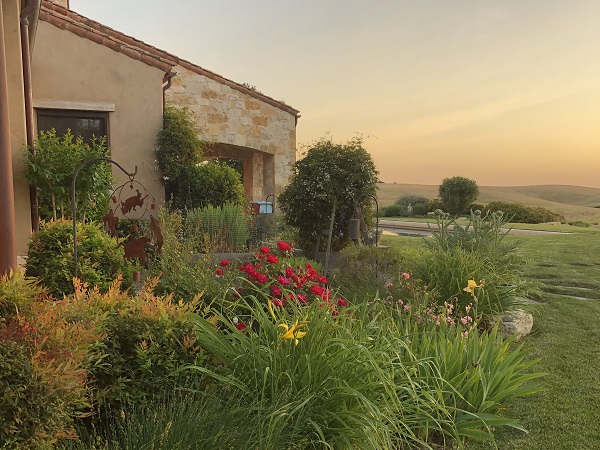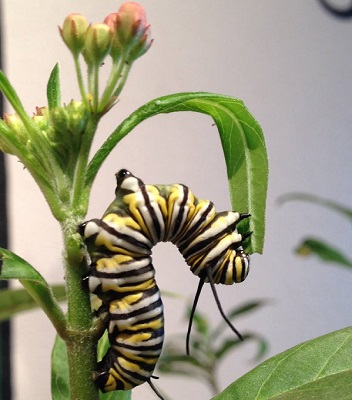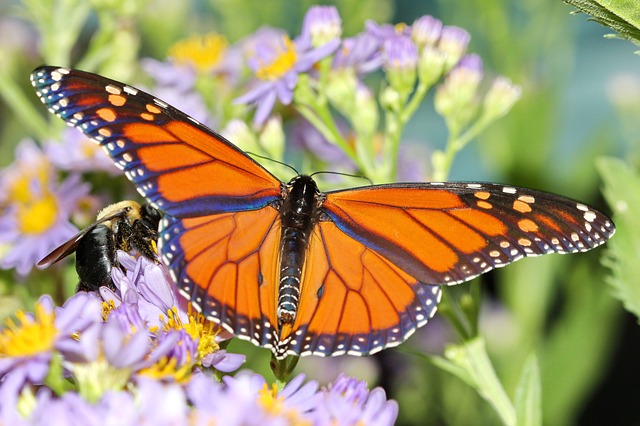Backyard gardens can help save the monarch butterfly
Local gardeners set an example with their certified wildlife habitat
–Local Congressman Salud Carbajal’s (D–Santa Barbara) recently announced support for two bills in the US House of Representatives to help save monarch butterflies and other pollinators, raised hope and stirred interest in saving the monarch. Backyard pollinator gardens can also play an important role in saving the declining monarch and pollinator populations. Adding the appropriate variety of native California milkweed to the garden is the best way to start.
Paso Robles gardeners Terry and Pam Barnes became monarch enthusiasts after visiting the Butterfly Grove in Pismo Beach a few years ago. “It was magical. We came home and planted butterfly bushes in our gardens. This year we planted our first crop of milkweed,” said Pam. Bees from the Barnes’ hives have disappeared and Pam said she didn’t see any monarchs in 2020. Along with creating the appropriate garden habitats for the butterflies, the pending legislation is, “what we should be doing to help the public realize nature in powerful,” said Pam. The Barnes’ Dresser Ranch property is a National Wildlife Federation Certified Wildlife Habitat.

One of Terry and Pam Barnes’ butterfly gardens waiting for the milkweed.
Monarch milkweed is critical to the survival of the monarch butterfly. Part of the depletion of the monarch butterfly population is attributed killing milkweed with herbicides, loss of wintering habitat, and climate change. Without the native milkweed varieties where the female monarch can lay her eggs and for the monarch caterpillar to eat, there are not enough new butterflies to keep the population vital.
Flower gardens are already pollinator gardens. Adding California native milkweed and other California native plants is an easy way to increase the variety of pollinators that visit your garden and create important habitat for the monarch. Other native California plants provide additional nutrition, shelter, and breeding habitats for pollinators such as the Anna’s Hummingbird that does not migrate, and native California bees.
Gardens that attract birds and insects are important said Brent Burchett, Executive Director of the San Luis Obispo County Farm Bureau. “I can tell you that Farm Bureau absolutely supports pollinator populations. The majority of our crops depend on pollinators. We know that when we spray for pests, we have to use specific management practices to safeguard bees, butterflies, and other pollinators.” Burchett also cautioned that milkweed can be toxic to livestock, but backyard gardens rarely graze livestock.
Danielle Bronson, State Park Interpreter for the Oceano Dunes District that includes the Pismo State Beach Monarch Butterfly Grove said, “Native milkweed needs to be planted in areas along the migration path a bit more inland from overwintering locations.” Planting milkweed in coastal areas within 10 miles of overwintering sites can encourage the monarchs to stay and feed rather than migrating and mating. “Planting milkweed near overwintering sites could have negative impacts for the population as a whole,” said Bronson. It’s also important to provide nectar plants during the time monarchs are returning to their overwintering sites.
Migration, caterpillars, and why native milkweed is important

A monarch caterpillar feeding on native California milkweed, Photo courtesy of California State Parks and Recreation.
The United States Forest Service reports that the monarch is the only butterfly known to make a two-direction migration as birds do. Monarchs cannot survive the cold winter of northern climates so they overwinter in warmer climates.
There are two groups of monarch butterflies; those that live and migrate west of the Rocky Mountains and those doing the same east of the Rockies. Eastern monarchs overwinter in Mexico and migrate as far north as Canada in the warmer months.
The Western Monarch migrates into Canada and overwinters in California along the Pacific coast. Wintering monarchs roost in eucalyptus, Monterey pines, and Monterey cypresses. Once spring arrives the butterflies mature and begin to breed and reproduce along the northern migration path, laying eggs on the Monarch milkweed.
A monarch butterfly lives up to five weeks, spending its time searching for food mating, (several times in that short life) and laying eggs. The butterfly feeds on nectar including that from the monarch milkweed flowers.
- The female monarch lays one egg at a time on a milkweed leaf, although she can lay hundreds of individual eggs. The eggs hatch three to five days later.
- The monarch caterpillars, feeding exclusively on milkweed, grow for about two weeks.
- Around two weeks after hatching, the caterpillar forms a chrysalis and begins turning into a butterfly.
- After two weeks the butterflies emerge and continue the cycle of mating, laying eggs and migrating for four or five generations.
- The final generation that returns to the winter groves has a longer life span of eight or more months. This is the generation that starts the new life cycle in the spring.
There are many varieties of monarch milkweed. The alkaloids from the plant gives caterpillars some defense against predators. Alkaloids from different varieties of milkweed on different migration paths may not provide the same level of protection.
Tropical milkweed (Asclepias curassavica) is a popular non-native variety sold in many nurseries. Unfortunately, this variety is host to Ophryocystis elektroscirrha (OE), a debilitating parasite that infects monarchs, causing difficulty emerging from their pupal cases, problems expanding their wings, and decreasing their chances of survival. Native California milkweed varieties do not host OE and the Western monarch caterpillar has no defense against it.
To discover which milkweed is native to your neighborhood, visit the Calscape website and enter your zip code. Calscape is managed by the California Native Plant Society (CNPS) to provide information about California native plants.
According to Calscape, the milkweed varieties for Paso Robles’ zip code 93446 are:
- Narrow Leaf Milkweed (Asclepias fascicularis)
- Kotolo Milkweed (Asclepias eriocarpa)
- Woolly Milkweed (Asclepias vestita)
These California milkweeds are drought-tolerant perennials that grow from seeds and spread from rhizomes and die back in late fall. Established milkweed begins sprouting in late February and early March, starts flowering soon after the stalks reach a few feet tall, and continues to flower through the summer.
In the fall, milkweed produces pods that burst open exposing silky fibers holding the seeds. You can harvest the plentiful seeds to plant and share and let the birds and wind spread them.
Learn more
- The California Native Plant Society is an excellent resource for learning about native plants and the varieties of native milkweed.
- Las Pilitas Nursery in Santa Margarita specializes in California native plants and is a respected source for information.
- Visit the S. Fish and Wildlife Service, the Xerxes Society, Save the Western Monarchs and Western Monarch Advocates.
- On the Central Coast, the Pismo State Beach Monarch Butterfly Grove is an excellent source of information.
Comments
Jackie Iddings is a contributing reporter and photographer for the Paso Robles Daily News.























